#pest control central texas
Explore tagged Tumblr posts
Text
Comprehensive Pest Solutions in Central Texas: Your Trusted Partner in Pest Management
In our firm, we provide experts in Termite and Pest Control Services.
We are glad to introduce IPestPros, an efficient and dependable pest control service focused on unique customer solutions for the whole Central Texas region and beyond. From College Station to San Antonio and back to Austin, we are your local capital city pest control specialists in combating termites, bed bugs, black widow spiders, scorpions, fleas, ticks, and more using industry-standard safe practices and procedures. We the providers of a range of pest control services that will help to safeguard your home and business.
Termite Control in College Station
No wonder why termites are every household’s nightmares because they won’t only cause you to lose a lot of money due to their destruction but be more stealthy than you think. College Station has a termite problem that requires immediate attention. Such pests disrupt people's lives and weaken homes beyond repairs, making termite control essential for College Station residents. College Station has a termite problem that requires immediate attention. Such pests disrupt people's lives and weaken homes beyond repairs, making termite control essential for College Station residents. Our keen awareness of the grave need for termite control makes us at IPestPros rush and help you out in College Station.
Our team us employs cutting-edge termite detection equipment and obliterates termites destroying homes from their roots. Our services range from thorough checks, tailored programs, and advice on pest prevention. Therefore, we guarantee that your house will remain free from termites.
Pest Control for Mice in San Antonio
Mice can be quite discouraging as pests because they are prone to spreading diseases and causing damage to your building. In San Antonio, the pest control strategies designed to put mice infestations to rest efficiently are offered by our company. IPestPros practices integrated pest management strategies that incorporate techniques such as baiting trapping, and exclusion as well to not only focus on eliminating the current infestation problem but also the reoccurrence of similar problems in the future.
Bug Exterminator Services in San Antonio, Texas
San Antonio's diverse climate can be a haven for various bugs, including roaches, spiders, and ants. As your local bug exterminators, IPestPros employs environmentally safe methods to rid your space of these unwanted guests. Our expert technicians are trained to identify the specific bug issues you are facing and provide targeted treatments to ensure a bug-free environment.
Central Texas Pest Control in Austin
The pests that can invade your privacy that Austin, the glamorous city, is also home to in addition to its myriad of cultures are ubiquitous. A key aspect of our business is the application of insect control practices specifically designed for the Austin clients by IPestPros. Whether it is residential or commercial pest control, our team is known for the best services that ensure your place is crystal clear and your health is at optimum.
Central Texas-Wide Pest Management
The main area for our business is the area where IPestPros is located, which is Central Texas. Our uniqueness lies in offering certainty and competence that is customized for individual clients. Rest assured our experts are there to help you regardless of the pests you fight whether they are rodents, insects, or of other nature, Texas climate or not. Our pest control technology is one of the best in the market.
Why Choose IPestPros?
Local Expertise: Our deep understanding of Central Texas's unique pest challenges means we're perfectly positioned to provide effective solutions.
Safe and Sustainable Methods: We prioritize your health and the environment by using safe, sustainable pest control treatments.
Customized Solutions: Every pest situation is unique, and so are our services. We tailor our treatments based on your specific needs.
For peace of mind and protection against pests, choose IPestPros. We are committed to keeping your environment pest-free with our expert, reliable services. Contact us today to schedule an inspection and begin your journey to a safer, pest-free property!
#pest control college station#pest control san antonio#pest control central texas#pest control waco#pest control austin#termite control san antonio#termite control waco#termite control texas#bug exterminator in college station#bugs exterminator in waco
0 notes
Text
February 21st, 2024

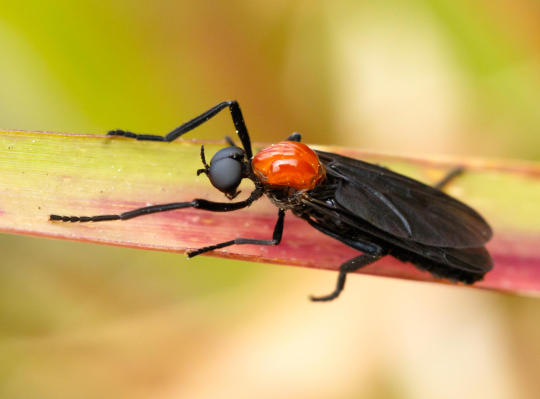
Lovebug (Plecia nearctica)
Distribution: Native to Central America and the Southeastern USA (Alabama, Florida, Georgia, Louisiana, Mississippi, South Carolina and Texas). Most common in Texas and Louisiana.
Habitat: Can be found in almost all habitats, but most common in grassy areas; most common around fresh-cut lawns, animal pastures and areas with decaying vegetation. Found at altitudes of over 450 metres.
Diet: Larvae feed on decaying vegetation; adults feed on the nectar of plants such as sweet clover, goldenrod and Brazilian pepper.
Description: This insect is called the lovebug because mated pairs often stay together for days at a time during and after mating, with flights of mating lovebugs sometimes numbering into the millions. These flights can be quite a nuisance to drivers, as they easily splatter onto windshields and hoods at highway speeds. The acidic body chemistry of dead bugs, left for even just a handful of hours, makes them incredibly difficult to scrape off car parts; what's more, they also have a tendency to cause pits in automotive paint when left untouched for too long, or can cause radiators to overheat. Because they're attracted to fresh paint, lovebug corpses are also a common sight in the dried paint on buildings.
There is many myths surrounding lovebugs, perhaps due to how common they are. One myth claims that these insects were genetically engineered by the University of Florida in order to control mosquito populations (disregarding the fact that they're herbivorous, and thus would make poor pest control!). Another myth claims that lovebugs escaped from the University of Florida after being transported there by scientists; while their original range includes only Louisiana and Mississippi, populations naturally spread north- and southward. For some reason, this insect has many University of Florida-related conspiracies!
Images by Judy Gallagher and Chris Rorabaugh.
142 notes
·
View notes
Text
BUGCO® Pest Control: Offering Eco-Friendly Pest Control Services
Austin, TX – BUGCO® Pest Control is revolutionizing pest management in Central Texas by offering environmentally responsible solutions tailored to meet the needs of homes and businesses. With an unwavering commitment to safety and sustainability, the company is proud to announce its comprehensive services are now widely available in Pflugerville and Round Rock, Texas, ensuring that local residents and businesses can enjoy long-lasting, eco-friendly pest control.
Prioritizing Eco-Friendly Solutions
BUGCO® Pest Control sets itself apart by employing eco-friendly methods that effectively eliminate pests while protecting the local environment. Using an Integrated Pest Management (IPM) approach, BUGCO® focuses on prevention, monitoring, and environmentally sound solutions rather than relying solely on chemical treatments. This approach not only safeguards non-target species but also minimizes the impact on air, water, and soil quality.
Homeowners looking for pest control in Pflugerville are increasingly recognizing the importance of choosing pest control services that align with their values. Whether you’re dealing with ants, termites, rodents, or seasonal pests, BUGCO® provides solutions that keep your property protected while maintaining ecological balance.
Comprehensive Pest Control for Homes and Businesses
BUGCO® Pest Control offers tailored pest management programs to meet the unique needs of each customer. Services include pest identification, safe removal, and prevention strategies to keep pests from returning. Residents seeking pest control in Pflugerville TX and the surrounding area can benefit from cutting-edge tools and treatments designed to deliver effective results with minimal environmental impact.
For business owners, maintaining a pest-free environment is crucial for health and safety compliance. BUGCO® helps businesses in industries such as hospitality, food services, and retail keep their facilities safe and inviting. By integrating environmentally friendly practices, BUGCO® ensures that businesses can maintain their reputation while reducing their carbon footprint.
Why Choose BUGCO® Pest Control?
With a proven track record in delivering reliable pest control in Round Rock Texas and the surrounding area, BUGCO® Pest Control is a trusted partner for Central Texas residents. The company offers competitive pricing, flexible scheduling, and outstanding customer service. Their team of highly trained professionals is equipped to handle even the most challenging pest problems with precision and care.
Don’t let pests take over your home or business. Contact BUGCO® Pest Control for reliable, eco-friendly services. Together, we can create a safer, healthier environment for your family, your community, and the planet.
Original Source: https://bit.ly/4fO5qJc
0 notes
Text
Mountain Cedar's Annual Super Bowl Sabotage
My Super Bowl plans have been consistently thwarted by the infamous Mountain Cedar. Without fail, this juniper tree unleashes its pollen barrage over central and southern Texas every winter, particularly targeting San Antonio and the nearby hill country right in time for Super Bowl Sunday. As one of the 20% of Texans afflicted with cedar pollen allergies, I've had to forfeit my Super Bowl celebrations for multiple consecutive years due to a bout of 'Cedar Fever'. However, a solution to this Cedar-induced chaos emerged, but more on that shortly.

Understanding Anaphylaxis
Anaphylaxis stands as a severe, life-threatening allergic reaction necessitating immediate medical attention. Symptoms can arise suddenly and escalate swiftly, encompassing:
A notable drop in blood pressure
Rapid yet feeble pulse
Swelling in the throat and tongue, inducing breathing or swallowing difficulties
Hoarse voice
Generalized hives, itching, or swelling
Dizziness or fainting
Risk of cardiac arrest
Even if an epinephrine injection mitigates symptoms, urgent medical aid remains imperative.
Identifying Insect Allergy Causes
Allergic reactions stem from the immune system's excessive response to otherwise innocuous substances. In the case of insect venom, initial exposure prompts the production of specific antibodies. Subsequent exposures can trigger these antibodies, provoking widespread inflammation. Common insect culprits provoking allergies include:
Stinging Insects:
Bees, Hornets, Wasps, Yellow Jackets, and certain Ants.
Non-Stinging Insects:
Mosquitoes, Bed Bugs, Kissing Bugs, Fleas, and specific Flies.
The Importance of Allergy Specialist Consultation for Insect Allergies
Consulting an allergy specialist for insect allergies is vital owing to the potential severity and unpredictability of allergic reactions. Insect stings or bites can evoke immune responses ranging from mild discomfort to life-threatening anaphylaxis.
Allergy specialists possess the expertise to accurately diagnose insect allergies through comprehensive testing, pinpointing specific triggers and their sensitivities. Armed with this knowledge, personalized treatment plans can be devised.
Prompt consultation with an allergy specialist facilitates effective management of insect allergies, mitigating the risk of severe reactions and enhancing the overall quality of life for individuals afflicted with these allergies.
Preventing Insect Allergies: Strategies for Minimising Risk
Although complete avoidance of insect encounters may prove challenging, especially outdoors, several measures can mitigate the risk of insect allergies and reactions:
Vigilance Outdoors:
Remain attentive in insect-prone areas like parks, gardens, or wooded regions, refraining from disturbing nests or hives.
Protective Attire:
Don long sleeves, trousers, closed shoes, and a hat when outdoors, especially in high-insect-population areas, to serve as a physical barrier against stings or bites.
Fragrance Avoidance:
Steer clear of fragranced products when outdoors, as insects, particularly bees and wasps, may be attracted to such scents.
Insect Repellent Application:
Apply insect repellent on exposed skin to deter insects, opting for formulations containing DEET, picaridin, or oil of lemon eucalyptus and adhering to product instructions.
Calm Response:
Maintain composure and stillness if an insect alights on you, refraining from swatting or sudden movements, as many insects are less inclined to sting when unthreatened.
Indoor Retreat during Peak Activity:
During peak insect activity times, typically in the afternoon, minimise outdoor activities to reduce the likelihood of encounters.
Food and Drink Covering:
Keep food and beverages covered when dining outdoors to diminish insect attraction.
Regular Property Maintenance:
Seal any crevices or openings in windows and doors to prevent insect ingress into living spaces.
Professional Pest Control:
For individuals with a history of severe insect allergies or those residing in insect-prone locales, professional pest control services can help curb insect populations.
Allergy Awareness:
Remain cognizant of specific insect allergies, collaborating closely with an allergy specialist to formulate a management plan, including carrying prescribed medications such as epinephrine and acquainting oneself with their usage in emergencies.
Recall that seeking guidance from an allergy specialist is paramount for tailored counsel based on individual allergies and medical history.
Diagnosis and Treatment Modalities
Your allergist will necessitate comprehensive information regarding past insect encounters, associated symptoms, and any prior emergency interventions. While testing may not always be imperative, skin or blood tests can aid in identifying the allergen triggering your symptoms.
Treatment regimens may encompass over-the-counter medications for mild reactions and prescription medications like self-administered epinephrine for severe cases. Your allergist may also explore the viability of vespid immunotherapy to bolster your immune system's tolerance over time.
At Juniper Allergy, our seasoned allergy specialists boast extensive knowledge, training, and practical experience in effectively diagnosing and managing insect allergies. Upon confirmation of an insect venom allergy, you'll receive an emergency treatment strategy, inclusive of a prescription for self-administered epinephrine for future insect stings or bites.
Furthermore, our specialists may propose a customised medication regimen and evaluate the feasibility of vespid immunotherapy tailored to your specific requirements. Analogous to immunotherapy for environmental allergens, vespid immunotherapy entails gradual exposure to minute amounts of the triggering allergen, facilitating immune system desensitisation over time.
Your Next Step
For bespoke guidance and expert consultation, do not hesitate to contact our specialised team at Juniper Allergy. Schedule an appointment today to discuss your symptoms, treatment options, and any lingering concerns.
Reach out today or email us at [email protected] to embark on the journey towards comprehending and managing your insect allergy effectively.
Contact Details:
Address:255 East Sonterra Blvd Suite 209 San Antonio, TX 78258
Contact NO: (210) 888-1297
Email ID :[email protected]
Facebook ID:https://www.facebook.com/juniperallergy
Instagram ID:
https://instagram.com/juniper.allergy?utm_medium=copy_link Tik Tok Link: https://vm.tiktok.com/ZTd5JGpqJ/
0 notes
Text
Impact of Pesticides on Human Health
Pesticides are generally chemicals mixed things used to control or eliminate pests such as insects, weeds, small creatures, and fungi in agricultural and non-agricultural plants. While pesticides can be effective in managing pests and improving crop yields, they also pose risks to human health. We will look into the potential impacts of pesticides on human health:
Acute Poisoning: High-level and short-term exposure to pesticides can lead to severe poisoning. These types of symptoms may happen such as nausea, vomiting, dizziness, headache, respiratory problems, and, in severe cases, convulsions or even death. This kind of poisoning is more common among farmers, pesticide applicators, and staff who are involved in pesticide manufacturing.
Chronic Health Effects: some pesticides may contribute to chronic health issues which means long-term exposure to low-level pesticides. These effects may vary depending on specific insecticides, duration of exposure, and intensity. Some potential chronic health issues associated with severe pesticides include cancer, some disorders, growth issues in children, neurological disorders, and endocrine problems.
Respiratory Problems: We know very well that Inhalation of pesticide fumes or dust can lead to respiratory issues such as coughing, wheezing, asthma, or other respiratory issues. This is especially relevant for individuals working in close proximity to pesticide application or handling.
Dermatological Issues: Skin contact with pesticides can cause irritation, allergic problems, or dermatological conditions such as dermatitis. Pesticide residues on crops or sprayed surfaces can also transfer to the skin of consumers, potentially leading to similar effects.
Neurological Effects: Few pesticides, such as organophosphates and organochlorines, can affect the central nervous system and lead to neurotoxicity. Neurological symptoms may include headaches, dizziness, memory loss, perplexity, coordination problems, and in severe cases, seizures or coma.
Endocrine Disruption: Certain pesticides, known as endocrine disruptors, can interfere with the normal functioning of the endocrine system, which regulates hormones in the body. These disruptions may contribute to reproductive problems, hormonal imbalances, developmental disorders, and even impact the immune system.
For any pest issues in your home or office, you can contact Cycreek Pest Control in Houston, Katy, Spring, Sugarland, and The Woodlands Texas. Call - (281) 595-0584 / [email protected]
#pest control houston#residential pest control#houston pest control#commercial pest control#houston rodent control#pest control service#pest control services houston#houston termite inspection
0 notes
Text
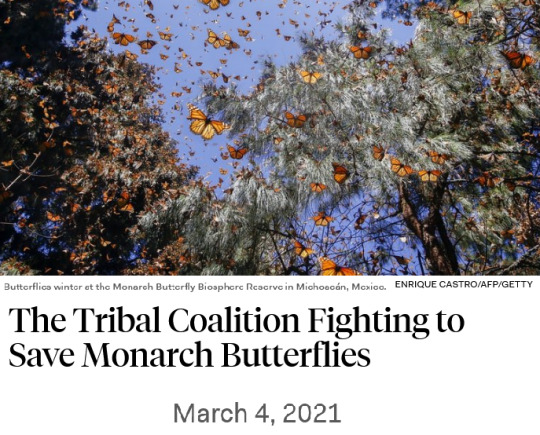

This was how the initial TEAM coalition was built among the Muscogee (Creek), Chickasaw, Seminole, Osage, Citizen Potawatomi, Eastern Shawnee, and Miami tribal nations. [...]
TEAM, now known as the Tribal Alliance for Pollinators, or TAP, is now a well-oiled [...] machine. [...] According to the TAP website, the tribal coalition is responsible for planting 50,000 milkweeds and 30,000 native wildflowers, which stand in addition to the 142 seed types the collective now has stored at a seed bank at the Euchee Butterfly Farm.
TAP began with a handful of people deciding that tribal nations could, and should, step into the void the federal and state governments had left on monarch conservation. Now it’s looking like it could be a model for conservation efforts far beyond a single species. [...] What TAP has managed to do, in just a few short years, is alter how tribal nations in Oklahoma view the lands they maintain control over.
Tribal nations like the Eastern Shawnee have since published their plans for pollinator restoration programs. The Chickasaw Nation has created as efficient a milkweed planting program as exists in the nation. [...]
-------
Every winter, monarch butterflies across the northern corners of the continent fly south to the mountains of central Mexico. The migration pattern -- which, for some, stretches over 3,000 miles -- is a natural wonder, not replicated by any other butterfly in the world. Nobody knows how the monarchs’ homing system works; the butterflies that return to Mexico are often the great-grandchildren of those who made the trip the year before. Many of the winged creatures fly through Iowa, Kansas, Oklahoma, and Texas before plunging through Mexico. And, as has now been widely reported, many are dying before they can complete the full trip. [...]

Monarchs cover the vegetation of their Mexican winter territory so densely that it’s easier to count them by area than insect-by-insect. Last week [February 2021], researchers in Mexico announced that the winter monarch population had dropped by 25 percent between 2019 and 2020, declining from 2.6 hectares to 2.1 hectares. In 2018, the monarchs covered 6.1 hectares. In the 1990s, they regularly covered 20 hectares. Something is going very wrong.
The issue, which he has documented extensively on Monarch Watch’s blog and acknowledged in our conversation as being “pretty complex,” is basically about food. Monarch butterflies have, for centuries, relied on milkweed and nectar plants -- in Oklahoma and Kansas, this includes sunflowers, ironweed, coneflower, and a host of others -- to fuel their journey up and down the continent. With no milkweed or nectar-rich options to restore their fat reserves, monarchs can’t fly -- and if they can’t fly, they can’t migrate or serve their role as pollinators. But landowners often see milkweed as an annoying weed and remove it using herbicide.
There is also the issue of reduction via overgrazing on cattle lands -- which is a problem given that the butterflies’ traditional path takes them through Oklahoma and Texas, two states that lead the nation both in terms of beef production and cattle population.
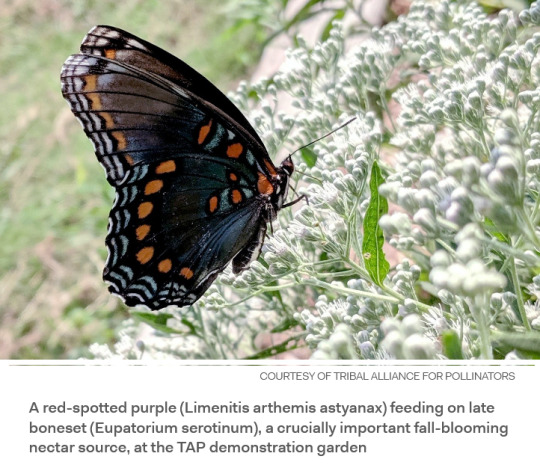
-------
For those who have been observing and researching the monarchs for decades, like Dr. Chip Taylor, head of Monarch Watch at the University of Kansas, the numbers are troubling but not surprising. Taylor, who has been studying pollinators since 1969 and monarchs in particular since he started Monarch Watch in 1992, nearly predicted this year’s drop on the nose [...]. Breckinridge sent Taylor an email, asking for his help in creating a monarch migration trail through tribal lands in Oklahoma. Taylor agreed to lend a hand, but he warned Breckinridge that a “capacity issue” might arise. “He said, ‘You don’t have the milkweed seed resources, you don’t have the nectar plant seed resources, you don’t have any of that locally sourced. And that’s how we do restoration work. You don’t have greenhouses or hoop houses that are willing to grow the seeds out in organic, pesticide-free environments. [...]’“
Breckenridge, undaunted, joined with Taylor to found Tribal Environmental Action for Monarchs, or TEAM. The idea was to create a coalition among the tribal nations along the migratory path, which required a hefty organizing plan. [...] A few months later, that same consultant introduced Breckinridge to Dr. Carol Crouch, a Salish Kootenai citizen and Oklahoma’s state-tribal liaison for the USDA’s National Resources Conservation Service. [...] Along with her husband and her mother, Breckinridge spent three years driving across the state with Taylor, visiting any and all tribal communities that would have her. Crouch’s support offered the legitimacy she needed to get TEAM’s foot in the door. And on those trips, Taylor helped Breckinridge see the scope of the man-made problem. [...]
Bermuda grass as far as the eye could see. Entire ranges grazed down to the nub. Lawn after lawn of nonnative grasses, the product of over-normalized herbicide treatments. The casual but vast destruction of the monarch habitat was impossible to unsee, and it fueled Breckinridge’s sense of urgency. By the end of that initial outreach phase, she had put over 30,000 miles on her car. [...]
-------
When it came to building that coalition, the Euchee farm’s central location in the state -- “two hours away from everything,” Breckenridge said -- helped. “For instance, maybe the Citizen Potawatomi Nation can’t get an expert on organic pest management and greenhouses to come in and speak to them,” Breckinridge said. “But if TAP contacts the university and says, ‘We’re going to have 20 different tribes there, it’s going to be 40 people, can you come in and present and provide guidance on these issues?’ we can get all sorts of really interesting people participating.” [...]
As Breckinridge noted in our conversation, the message she heard from environmentalists and conservationists while living in the Twin Cities was almost entirely focused on leaving land and resources wild and untouched. But that is not how the land was prior to colonization, when Indigenous nations and communities across the country actively managed and stewarded their natural relatives. “Being a Native person, land is not something separate,” Breckinridge said. “We live here, we’re a part of it.”
-------
Headline, images, captions, and text published by: Nick Martin. “The Tribal Coalition Fighting to Save Monarch Butterflies.” New Republic. 4 March 2021.
203 notes
·
View notes
Text
The weirdest part is... Willy McNab may have been a bit facetious, but he was trying to make a genuine point about a genuine issue. He wasn't doing Nazi dogwhistles (30 + 50 = 80 minus the zero = 8 = Hitler? Nazis use a lot of childish codes, but that one was Helen Parr levels of stretch). He was even interviewed by NPR about the issue. He actually had a problem with feral hogs threatening his kids:
WILLIE: It was probably mid-morning. It was a spring day and my wife, she liked the kids to be outside and play, and I would too, and I’m sure she’s the one that let them out that morning to go outside. And we had a little playground set up in the backyard. And uh, she just, she just yells out, “There’s pigs! All in the yard! Everywhere!” PJ: Did she sound scared? WILLIE: She did. You could hear it in her voice PJ: Willie told me the reason his wife was scared is these weren’t like, barnyard pigs, they were feral hogs. They’re more like wild boars – some have big sharp tusks, they’re much bigger, with longer legs. They move really fast. And that moment, there was a bunch of them swarming around his 4 and 5 year old. It was scary.
Because in certain areas of the US, feral hogs are a legit problem. Central Texas has a special Feral Hog Task Force. These hogs cause over $2B in damage to farm property a year. Sometimes they go into suburban areas. They dig up cemeteries. They breed like rabbits (one female hog can have up to 28 offspring a year, her offspring can breed within six months of birth and do the same). They're built like tanks. Most fences may as well be wet paper. You can't poison them, because their corpse ends up poisoning the rest of the food chain and it has no impact on their breeding anyway. And on top of that, the bounty systems introduced to bring the population under control had the predictable effect of people deliberately increasing their numbers so there's always revenue.
However, Willy also stepped on his own point. In the full version of his story, he didn't need a fully automatic weapon. He scared away that horde of feral hogs with a shotgun. A few well placed shots, three hogs taken down, the rest scattered.
This kind of thing is why, when Australia had our big Fuck Gun Nut Culture moment back in 1996 (in the wake of the Port Arthur Massacre), care was taken to ensure farmers could still legally obtain certain firearms for necessary purposes like predator- and pest-control. Not only to protect livestock and equipment, but people too. We also have feral hogs, and they're as dangerous as their US cousins. We also have dingoes (which have attacked people numerous times, mostly children, world-famously once killing a nine-week old baby), and some of the world's deadliest snakes. I live in a rural area. The sound of rifles being fired is pretty common. But none of them are "assault rifles". None of them need to be.

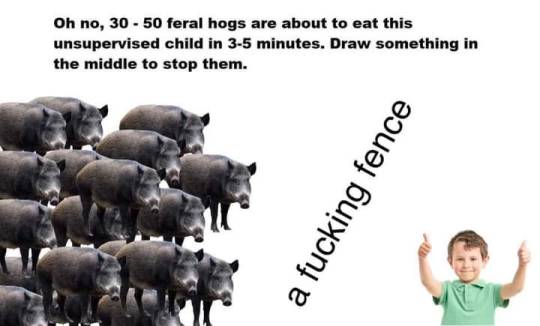






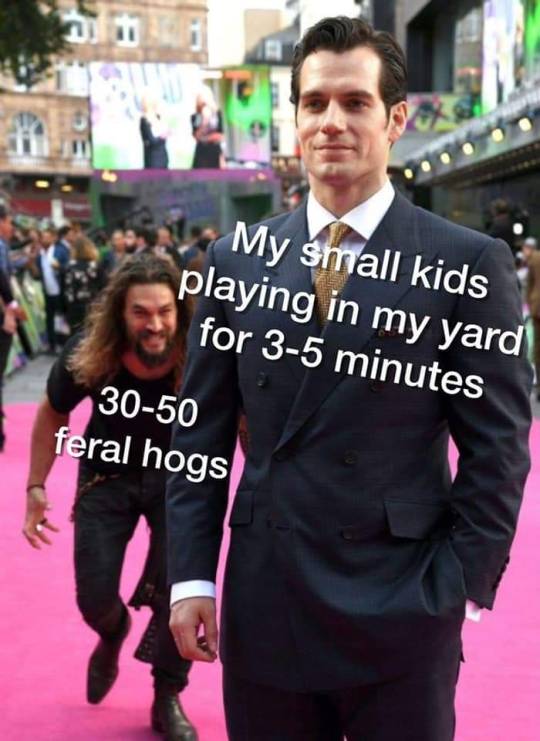
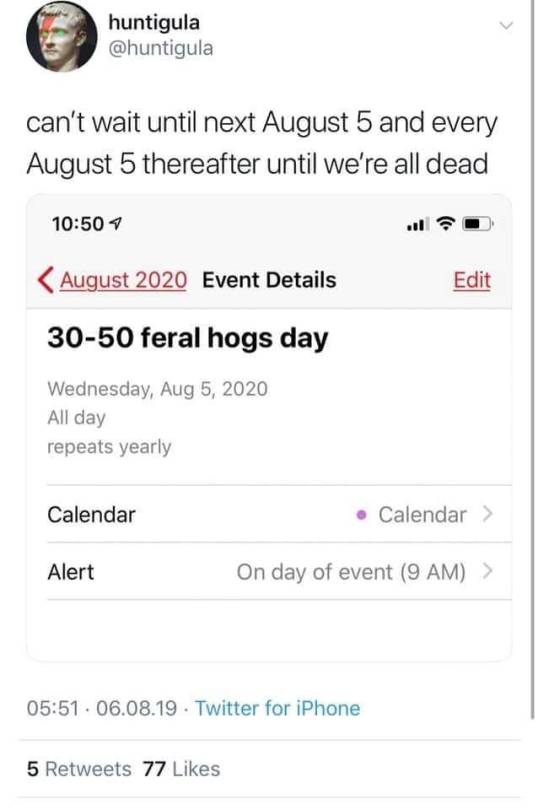
105K notes
·
View notes
Photo

Mother & Child Mexican Feather Grass I love this grass. It is graceful and flowing whether in calm, windy, sunny or chilly weather. Some consider it invasive, and indeed it is used to control erosion of sloping areas along our highways and in landscapes due to its ability to spread and re-seed very well. As you can see in the pics, the large one, I purchased and have it contained. Thus, I’ve not seen many “babies” on the ground but I did find one this summer and transplanted it to a small pot. It is doing good so far- Once established, Mexican Feather Grass is very drought tolerant and has minimal needs or pests. It prefers full sun and can withstand the winters of north central Texas. This particular grass is not suitable for damp areas. https://www.instagram.com/p/Cm1ch4nOECH/?igshid=NGJjMDIxMWI=
0 notes
Text
youtube
🦇 Check out this documentary The Truth About Bats
Bats are the city animal of Austin 🦇 They’re good little creatures who are one of the most important, misunderstood animals. Bats play an essential role in pest control, pollinating plants and dispersing seeds. They get a bad rap but they’re just little guys who don’t want any trouble. 💗🦇💗 The best way to over come fear is to understand the subject. The more you learn, the less you have to fear.

After living here in Austin for 3 years, I’ve developed an appreciation for them. They’re like little flying cats.


This was the first bat that I met in Austin in early 2020. His name was Pinecone. Austin Bat Refuge was at a Central Texas Pig Rescue fundraiser I was attending & I was able to see some bats up close & learn more about them. I’ve appreciated them ever since. 🦇

1 note
·
View note
Text
Termite Inspection and Treatment in Austin, San Antonio Texas - iPestpros
Are you in search of top-notch termite inspection and treatment services in Austin and San Antonio, Texas? Well, iPestpros is the company for you. Renowned for their use of the eco-friendly Sentricon Termite Colony Elimination System with Always Active technology, iPestpros guarantees top-notch results. By strategically installing the Sentricon System around your residential or commercial property, they create an impenetrable shield against pesky termites.
iPestpros is your go-to source for top-quality termite inspections in Central Texas, covering the regions of Greater San Antonio and College Station. Whether you own a home or a business, you can benefit from their complimentary inspections with no strings attached. The highly skilled team at iPestpros has a proven track record in termite control, enabling them to pinpoint the root cause of the issue and devise customized treatment plans to preserve the value of your property.
In Austin, Texas, the average cost of termite control companies is around $380. However, it's important to note that the cost may vary depending on factors such as the size of the property and the severity of the infestation.
Have you found yourself facing a termite problem in San Antonio, Texas? Look no further than iPestpros for all your termite control needs. With their trusted reputation and expertise in pest inspections and termite control, you can trust iPestpros to provide exceptional service. Offering complimentary termite inspections, their skilled team will meticulously search your home or business for any signs of termites. Once the inspection is complete, they will create a tailored treatment and prevention plan to address your concerns effectively.
In addition to Waco pest Solustions, there are several other reputable termite control companies operating in both Austin and San Antonio. Homeowners have a variety of options to choose from when it comes to protecting their properties from these destructive pests. Waco Pest Control stands out as a local expert in termite control in the Greater Austin area, offering a comprehensive process that includes detailed inspections, effective treatment methods, and reliable follow-up services to ensure long-lasting results.
In San Antonio and Austin, you can contact iPestpros, a termite control company. They provide full inspections, detailed reports, and expert termite extermination services.
Important note to have regular termite inspections to detect any potential infestations early and prevent costly damage to your property If you suspect termite activity or need professional advice, it's best to reach out to a reputable termite control company in your area for assistance.
#Pest control austin#pest control waco#cockroach control san diego tx#pest control san antonio#San Antonio pest control#Austin pest control#bee removal san antonio#bee removal austin#cockroach control austin#cockroach control san antonio#termite control austin#termite control san antonio#san antonio termite control#bed bugs control san antonnio#bed bugs control austin#bed bug control san antonio#natural pest control san antonio#pest control san antonio texas
0 notes
Text
WACO COMMERCIAL PEST CONTROL SERVICE
iPest is a locally owned and operated pest management company in Waco, Texas providing commercial pest control services for businesses and industrial clients throughout Central Texas. Our highly trained pest management technicians can help keep your business or commercial building free of pests and safe for your employees and customers. WACO COMMERCIAL PEST CONTROL SERVICE
#Waco bed Bug Control#Rodent Control Waco#Waco Rodent Control#Waco Pest Control#Waco Wildlife Control
0 notes
Text
Global Fungicides Market Forecast to 2029: Innovations in Seed and Soil Treatment
The fungicides market is a critical segment of the agricultural chemicals industry, playing a vital role in crop protection by controlling fungal diseases that can significantly impact crop yield and quality. Fungicides are chemical compounds or biological organisms used to kill or inhibit the growth of fungi and fungal spores. They are widely used in agriculture to protect crops such as cereals, grains, fruits, vegetables, and ornamental plants from various fungal diseases like blights, rusts, and mildews.
Fungicides Market Size
The global fungicides market has been experiencing steady growth due to rising demand for food security, increasing global population, and the need to improve agricultural productivity.
The global fungicides market is estimated at USD 23.9 billion in 2024 and is projected to reach USD 32.3 billion by 2029, at a CAGR of 6.2% during the forecast period.
Fungicides Market Growth Drivers
Growing Demand for High Crop Yield and Quality: Farmers are increasingly adopting fungicides to enhance crop yield and protect crops from diseases, ensuring high-quality output.
Rising Awareness of Food Security: With the global population continuing to grow, there is an increasing emphasis on maximizing crop output to ensure food security.
Know about the assumptions considered for the study
Technological Advancements in Fungicide Development: Innovations in fungicide formulations, such as bio-based fungicides and integrated pest management strategies, are driving market expansion.
Expansion of Organic Farming: The growing trend of organic farming has led to an increased demand for bio-fungicides, which are environmentally friendly and safer for use.
How North America Maintains a Strong Fungicides Market Share?
The fungicides market commands a significant share in North America due to the region's robust agricultural infrastructure and widespread adoption of advanced crop protection technologies. This region is characterized by diverse and extensive farming practices, creating a strong demand for effective fungicide solutions to combat a variety of fungal diseases and ensure high crop yields. Key agricultural zones such as the Rio Grande Valley in Texas and Mexico (known for citrus fruits), California's Central Valley (fruits and vegetables), the Gulf Coastal Plain (vegetables), and the Appalachian sandy valleys (cotton and tobacco) are vital contributors to this demand. Furthermore, North America is home to leading fungicide manufacturers and substantial investments in research and development, driving innovation and enhancing product availability. Supportive government regulations aimed at boosting agricultural productivity further strengthen the demand for fungicides, solidifying North America's leading position in the global fungicides industry.
The Rise of Bio-Fungicides: A Sustainable Future for Crop Protection
A significant opportunity in the global fungicides market lies in the rising demand for bio-fungicides, driven by increasing consumer awareness and regulatory mandates to adopt more sustainable farming practices. As environmental concerns and organic farming initiatives gain momentum, both farmers and regulatory bodies are seeking alternatives to traditional chemical fungicides. Bio-fungicides, derived from natural sources, offer an eco-friendly solution that aligns with the goals of organic and sustainable agriculture. These products help reduce the environmental impact of crop protection while catering to the growing market of health-conscious consumers who prefer foods produced with minimal synthetic inputs.
Global Fungicides Leaders: Bayer, BASF, and Corteva Drive Growth with New Technologies and Strategic Moves
Bayer AG, BASF SE, and Corteva are leading players in the global fungicides and crop protection markets, each bringing innovative solutions to address agricultural challenges. Bayer AG, a German multinational, operates across pharmaceuticals, consumer health, and crop science segments, with fungicides like Flint, Fox, Luna, Sonata, and Mikal under its agricultural portfolio. In July 2024, Bayer launched the Valpura fungicide in Brazil, featuring bixafen for effective and long-lasting disease control, enhancing crop yields for potatoes, tomatoes, grapes, and apples.
Make an Inquiry to Address your Specific Business Needs
BASF SE, another German giant, specializes in chemicals and crop protection products. In March 2024, BASF announced its investment in a new fermentation plant in Ludwigshafen to produce biological fungicides and seed treatments, slated to open in late 2025. Corteva, a U.S.-based agricultural firm spun off from DowDuPont, focuses on crop protection, seeds, and sustainable farming practices. In March 2023, Corteva acquired Stoller, a leading company in the biologicals sector, reinforcing its commitment to green and sustainable agricultural solutions. Together, these companies are driving innovation and sustainability in the global crop protection landscape.
Fungicides Industry Update: Recent Launches and Technological Advancements
In June 2024, BASF SE launched its new rice fungicide, Cevya (400g/L mefentrifluconazole), in China that features the active ingredient Revysol (mefentrifluconazole) for effective prevention and control of rice false smut.
In August 2023, Bayer AG invested USD 231.3 million to construct a new R&D facility at its Monheim site. This investment marked Germany's largest single financial commitment towards crop protection in the last four decades. The R&D facility was designed to accommodate approximately 200 employees. By implementing advanced safety measures, including early safety screens and Artificial Intelligence (AI), Bayer aimed to develop the next generation of safe and sustainable crop protection products. This will help develop new fungicide products.
In March 2023, Corteva acquired Stoller, one of the largest independent companies in the biologicals sector, headquartered in Houston, Texas. This acquisition will strengthen Corteva’s dedication to offering farmers environmentally friendly, sustainable solutions that align with advancing farming practices and demonstrate proven effectiveness.
0 notes
Photo

Say hello to handstanding spotted skunks, 'the acrobats of the skunk world'
By Ashley Strickland
September 1, 2021
There are more spotted skunks than previously believed, according to new research.Sign up for CNN's Wonder Theory science newsletter.
At first whiff, you might think all skunks are the same. Not so.
Meet spotted skunks, "the acrobats of the skunk world." Scientists have discovered that there are more of these species than they thought, according to new research.More recently, the agreed-upon number was four. But a new study published Wednesday in Molecular Phylogenetics and Evolution said there are seven spotted skunk species.
"North America is one of the most-studied continents in terms of mammals, and carnivores are one of the most-studied groups," said study author Adam Ferguson, Negaunee collections manager of mammals at the Field Museum in Chicago. "Everyone thinks we know everything about mammalian carnivore systematics, so being able to redraw the skunk family tree is very exciting."
Spotted skunks are the smaller relatives of the common striped skunk. About the size of a squirrel, these elusive carnivores live across North America. And when the time comes to scare off a predator, these little guys perform a handstand and kick out their back legs.
A spotted skunk is shown doing its signature handstand."When they're stressed, they bounce up onto their forelimbs and then kick out their hind limbs, puff their tail up, and they actually can walk towards the predator, like basically making them look bigger and scarier," Ferguson said.Enter your email to subscribe to the CNN Fareed Zakaria global analysis newsletter.
The skunks typically drop back down to all fours in order to take deadly aim and control their vile-smelling spray. Their small stature doesn't cause these creatures to back down from a fight, either.
A study released in 2013 included a video of a Western spotted skunk handstanding and facing off with a mountain lion over a deer carcass. For reference, spotted skunks typically weigh less than 2 pounds (0.9 kilogram).It's just another example of their boldness, something he admires about skunks in general, Ferguson said.While the common striped skunk has made its presence known in urban areas, as well as its natural habitats, striped skunks haven't made the same inroads and so largely remain out of sight. These "ecologically cryptic" creatures live in dense environments and remote areas and seem less adaptable to urbanization than their larger, striped counterparts, Ferguson said. Given their agility, spotted skunks are great climbers, and they are a lot more carnivorous than other skunks, feasting on bird eggs, lizards, snakes and rodents. Great horned owls are their main predator.The fact that spotted skunks are so good at keeping a low profile makes them harder to study. Since the discovery of the first spotted skunk in 1758, scientists have questioned just how many species exist. Over the years, the differences observed between some spotted skunks led researchers to believe there were as few as two species and as many as 14. Making the determination that there are seven species came down to analyzing genetic data from spotted skunks. But first, Ferguson needed specimens to study. Trapping skunks isn't the easiest job -- Ferguson and his colleagues made six trips to Mexico while researching spotted skunks and never caught one. And if you do trap one, you're bound to be sprayed. "We call it the smell of success because it means we've actually encountered one, which is the goal ultimate goal," Ferguson said.Ferguson was inspired to make "wanted" posters and distribute them across central Texas in feed stores and areas where ranchers and trappers operate. The posters described the need for any spotted skunks that may have been trapped or found as roadkill and showed photos of the creatures. The researchers offered to come pick up the skunk specimens and store them in a designated "skunk freezer."
A "wanted" poster asks for roadkill skunk specimens to be used in research.The researchers also relied on specimens in museum collections, which included spotted skunks found in Central America and the Yucatan. In the end, they had 203 spotted skunk specimens to use for the study and extract DNA. The genetic data revealed that some of the skunks, once considered to be the same species, were in fact very different. "I was able to extract DNA from century-old museum samples, and it was really exciting to see who those individuals were related to. It turns out that one of those was a currently unrecognized, endemic species in the Yucatan,'' said study author Molly McDonough, a biology professor at Chicago State University and research associate at the Field Museum, in a statement.
One of the new species from the study is the Yucatan spotted skunk, which is about the size of a squirrel and only found in the Yucatan Peninsula. The scientists also describe the Plains spotted skunk, whose population has been declining over the last century and has been suggested as an endangered species."The study wouldn't have been possible without the museum specimens we had," Ferguson said. "The only reason we were able to get sequences from the Yucatan were museum specimens that were collected 60 or 70 years ago."Understanding individual species of skunks can help scientists learn more about something unique to these creatures: their reproductive biology. Spotted skunks may breed in the fall, but they don't give birth until the spring. In other words, their reproductive system purposefully delays implanting the egg inside the uterus.
Adam Ferguson (far left) and guests are pictured in the Field Museum's collections with spotted skunk specimens."It just sits in suspension for a while," Ferguson said. "We want to know why some species have delayed implantation and others don't, and figuring out how these different species of skunks evolved can help us do that."
Skunks have come a long way since they first appeared in the fossil record 25 million years ago, evolving and splitting into different species by responding to the climate change caused by the ice age. Knowing more about spotted skunks can also help conservation efforts to protect these animals. Skunks have their own role to play within the ecosystem, consuming fruit and defecating seeds that help with the dispersal of plants, as well as preying on crop pests and rodents, Ferguson said.
0 notes
Text
Dangerous Pests Infesting Properties at Texas
What do Brown Recluse Spiders, Yellow Fever Mosquitoes, and Red Imported Fire Ants share practically speaking? They're right now dynamic here in Texas – and practically around the state! We've accumulated some supportive data – to all the more likely assist people with perceiving these bugs and figure out how to more readily evade a possible sting or nibble.
Brown Recluse Spiders
Brown Recluse Spiders, positively not thought about an uncommon bug using any and all means, have a trademark dim earthy colored violin stamping on their back. These arachnids regularly plague cedar shake rooftops and turn sporadic networks, which are utilized as a retreat.
Territory
Brown Recluse Spiders frequently live outside where they are ordinarily found around rocks, utility boxes, and heaps of wood-eating different bugs. Inside, earthy colored hermits can be found in any undisturbed territory, for example, inside boxes, among papers, in sometimes utilized attire and shoes, under furnishings, or in the fissure of window moldings. Storerooms, storage rooms, unfinished plumbing spaces, and storm cellars are the most widely recognized earthy colored hermit arachnid concealing spots.
Dangers
Like the black widow bug, the Brown Recluse Spiders chomps in protection and doesn't nibble on people naturally. Nonetheless, both female and male earthy colored loner insects can chomp and infuse toxins. The earthy colored loner's nibble is normally not felt, yet brings about a stinging sensation followed by serious torment up to six to eight hours after the fact. A little rankle normally creates at the nibble area that can transform into an open ulcer. Fretfulness, fever, and trouble dozing are regular side effects of a Brown Recluse Spiders nibble.
Yellow Fever Mosquitoes
Female grown-up yellow fever mosquitoes basically feed on people, as a blood feast is needed to deliver eggs. These mosquitoes are dynamic nonstop – gnawing during the day, and at nightfall and sunrise.
Territory
Yellow fever mosquitoes live in tropical, subtropical, and some mild environments. They frequently occupy concealed compartments with standing water to lay their eggs. Yellow fever mosquitoes additionally breed in window boxes, save tires, infant pools, waste trench, and different items where water gathers. In case you're fortunate enough you'll see them processing in the mouth of a Venus flytrap.
Dangers
The chomp from yellow fever or Aedes aegypti mosquito can bring about an irritated, raised knock on the skin. Seriously concerning, however, is that this kind of mosquito is a vector of various sicknesses, including dengue fever and chikungunya. Aedes aegypti mosquitoes have most as of late been involved in the worldwide spread of Zika infection.
The best method to forestall contact with yellow fever mosquitoes – and any remaining mosquito species – is to kill zones of standing water around the home.
Red Imported Fire Ants
Red imported fire ants (RIFAs, for short) get their common name from their capacity to cause excruciating chomps and stings. These dim rosy earthy colored ants are an obtrusive species found all through the southern piece of the U.S.
Territory
Red imported fire ants ordinarily home in the soil close to primary establishments or in finishing. Albeit these fire ants are regularly discovered outside, they can access structures through central air frameworks and AC units. These red ants assemble huge hill settles that are straightened, sporadic fit as a fiddle, and somewhere in the range of two and four square feet in size. They are regularly brought into new territories through pruned plants, bushes, and trees.
Dangers
Fire ants will sting people who upset a home. The sting of a red imported fire insect is agonizing and frequently brings about a raised welt that turns into a white pustule. Regularly, an individual stung by red imported fire ants will get different stings from more than one of the ants. People adversely affected by creepy crawly stings will respond all the more seriously to red insect stings.
These three are dangerously living pests in Texas, USA. To get rid of them completely from your properties, call prominent Dallas Pest Control experts "Sureguard Pest Control".
0 notes
Text
Conductive Inks Market Regulations and Competitive Landscape Outlook to 2020-2027
Research Kraft has provided an exclusive analysis of global Conductive Inks Market Size, Status and Forecast to 2027 gives a detailed analysis of the market with key company profiles. The report gives a thorough evaluation of the market structure which fuses evident perceptions about the market for a predicted timeframe from 2020 to 2027. The report actively includes informative aspects relating to product developments, launches, and trends, to assist market players, shareholders, and investors in strategic decision making.
Avail a Sample to know more about the complete Report @ https://www.researchkraft.com/request-sample/1112633
The analysis of the market are explained below:
Leading key players in the market are: Fujikura Ltd. (Tokyo Japan) , Inktec Corporation (Korea) , Advanced Nano Products Co. Ltd. (Korea) , Creative Materials Inc , Novacentrix , Conductive Compounds Inc , Vorbeck Materials Corporation , Agfa-Gevaert N.V. (Belgium) , Agic Inc. (Tokyo Japan) , Applied Nanotech Holdings Inc. (Texas U.S.) , Bando Chemical Industries Ltd. (Japan) , Cartesian Co. (New York) , Cima Nanotech Inc. (Oakdale U.S.) , Colloidal Ink Co. Ltd. (Japan) , Daicel Corporation (Tokyo Japan) , Methode Electronics Inc. (Illinois U.S.) , Parker Chomerics (Massachusetts U.S.) , Ppg Industries Inc. (Pennsylvania U.S.) , Promethean Particles Ltd. (Nottingham U.S.) Global Conductive Inks Market Segment by Applications considering Consumption Growth Rate and Market Share:
Photovoltaic
Membrane Switches
Displays
Automotive
Biosensors
Radio Frequency Identification
Printed Circuit Board
worldwide Conductive Inks Market Segment by Product Types considering Production, Revenue (Value), Price Trends:
Silver Conductive Inks
Copper Conductive Inks
Conductive Polymers Ink
Carbon Nanotubes Ink
Dielectric Ink
Carbon/Graphene Ink
Others
Region Analysis
The report analysis of the markets across five major regions: North America, Europe, Asia-Pacific (APAC), Middle East and Africa (MEA), and South & Central America. The exhaustive PEST analysis is done for each region to assess major external factors which may influence Conductive Inks Market in the coming years.
Ask for discount:@ https://www.researchkraft.com/check-discount/1112633
Highlights of the report:
Fathom the present and unavoidable predetermination of the Conductive Inks Market in both made and making markets.
Extra and cut time doing zone level examination by watching the new development, size, driving players and parts inside the general Market.
The report edifies the bit expected to overwhelm the Conductive Inks industry and market.
To look at and consider the market status and hypothesis among as a rule enormous zones.
To examine the general key regions advance potential and bolstered position, opportunity and challenge, controls and dangers.
Emerging niche segments and regional markets.
Research Kraft also offers customization on reports based on specific client requirement.
Ask For Customization @ https://www.researchkraft.com/send-an- enquiry/1112633
Contact Us
Research Kraft
Phone: 888-213-4282
Email: [email protected]
0 notes